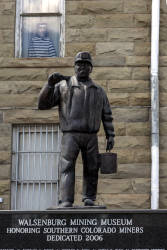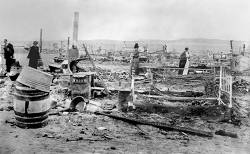Walsenburg Mining Museum
Useful Information
| Location: |
112 W. Fifth Street, Walsenburg.
I-25, between exits 49 and 52. (37.624752, -104.781816) |
| Open: |
All year Fri 10-12, 13-15, Sat 13-15. [2022] |
| Fee: | |
| Classification: |
 Mining Museum Mining Museum
 Coal mine Coal mine
|
| Light: |
 Incandescent Incandescent
|
| Dimension: | |
| Guided tours: | self guided |
| Photography: | allowed |
| Accessibility: | no |
| Bibliography: |
Ross B. Johnson ():
Geology and Coal Resources of the Walsenburg Area Huerfano County Colorado,
Geological Survey Bulletin 1042-0.
pdf
|
| Address: |
Walsenburg Mining Museum, 112 W. Fifth Street, Walsenburg, CO 81089, Tel: +1-719-738-1992, Tel: +1-719-738-2840.
E-mail: |
| As far as we know this information was accurate when it was published (see years in brackets), but may have changed since then. Please check rates and details directly with the companies in question if you need more recent info. |
|
History
| 23-SEP-1913 | strike called. |
| 28-OCT-1913 | National Guard called. |
| 20-APR-1914 | four men, two women, and 11 children killed. |
Geology
Around Walsenburg the northern part of the Raton Mesa region of southeastern Colorado, is composed of marine and non-marine sedimentary rocks that range in age from Late Cretaceous to Quaternary. Intrusive igneous rocks of Tertiary age are also abundant and conspicuously exposed. Beds of coal occur in the Vermejo and Raton formations of Late Cretaceous and Paleocene age. The Vermejo formation is between 75 m and 125 m thick, the Raton formation is between 3 m and 150 m thick Both consists of sandstone, siltstone, shale, and coal, and the formations are separated by a bed of conglomerate at the base of the Raton formation. The Vermejo contains 3 to 8 coal beds, and the Raton contains 1 to 3 coal beds, all more than 35 cm thick.
The Trinidad coal field in the Walsenburg area lies in hilly country northeast of the Spanish Peaks. The eastern and northern margins of the coal field are an escarpment formed by the Trinidad sandstone. About 260 km² of the Walsenburg area is underlain by coal, but a large part of the coal could not be reached because it lies more than 1,000 m beneath the surface.
Description

Walsenburg Mining Museum is located at Walsenburg, called the “City Built on Coal”. During the late 19th and early 20th centuries the economy of the town was based on coal mining. Obviously there were battles between the coal miners and mine operators. Mary “Mother” Jones was a famous labor leader and “the most dangerous woman in America.” She came to Colorado to help the colliers during their strike. At the age of 80 years, she was arrested and incarcerated in the Walsenburg jail, where the museum is located today. After her release, she headed to Washington, D.C. to testify about the deplorable conditions endured by the coal miners.
Colorado’s colliers experienced twice the number of deaths compared to anywhere else in the world. This was a result of the conscious negligence towards safety measures by the mine owners. Complaining miner were fired, and as the companies provided most housing, anyone who was fired was immediately homeless. The mine owners used blunt and most likely illegal tactics, like tarring and feathering, beating, or abandoning union miners on remote stretches of prairie.

In 1913 the United Mine Workers of America presented the mine owners a list of seven demands. From our viewpoint they were quite basic, for example the right to shop in any store they chose, or the enforcement of Colorado mining laws, and the eight-hour workday, which was already a state law but generally ignored. The union tried to block any strikebreakers’ traffic and those confrontations between striking and working colliers sometimes resulted in deaths. The mine owners hired the Baldwin–Felts Detective Agency to protect the strikebreakers and harass the strikers. Baldwin–Felts had a reputation for aggressive strike breaking by firing bullets into tents at random, occasionally killing and maiming people. They used a custom made armored car named Death Special with a mounted machine gun. Finally Colorado Governor Elias M. Ammons called in the Colorado National Guard. But the cost was bankrupting the state and so all but two of the troops were withdrawn. And on 20-APR-1914 bombs went up and bullets began ripping through the tents, the tents were torched and finally four men, two women, and 11 children were killed at that day. It was named the Ludlow Massacre and caused a public outcry, people hit the streets to protest in major cities across the United States. And it started the Colorado Coalfield War or Ten Days War, colliers retaliated by settting fire and destroying mine buildings and workings with dynamite. At the end 50 people were dead and President Woodrow Wilson sent in Federal troops to disarm both sides.
The museum is operated by the Huerfano County Historical Society. It is located in the 1896 Historic Jail building behind the Courthouse. Beneath mining history represented by historic documents and photographs the museum has mining equipment like lamps and helmets, personal gear and belongings. Several dioramas are depicting mining life. But the museum also tells local history, for example the story of Bob Ford who is famous for killing Jesse James. He killed another man in Walsenburg and went to this jail.
 Search DuckDuckGo for "Walsenburg Mining Museum"
Search DuckDuckGo for "Walsenburg Mining Museum" Google Earth Placemark
Google Earth Placemark Walsenburg Mining Museum, official website (visited: 20-JUN-2020)
Walsenburg Mining Museum, official website (visited: 20-JUN-2020) Index
Index Topics
Topics Hierarchical
Hierarchical Countries
Countries Maps
Maps